Conducting Laboratory Experiments via the Internet
Teaching food science and engineering via Internet-assisted remote-controlled experiments provides benefits for students and instructors
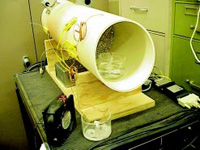 Educational Value of the Internet
Educational Value of the Internet
What sets the Internet apart from other technological innovations—including radio and television—that have transformed other aspects of society but fallen short of inflated expectations in the realm of advanced learning? According to Neil Rudenstine, president of Harvard University, “We see evidence of rapidly expanding educational use. . . . There is a very close fit—a critical interlock—between the structures and processes of the Internet and some of the main structures and processes of traditional university education. The new technologies act as a powerful supplement to, and reinforcement of, forms of teaching and learning that faculty members and students for decades have found to be especially effective.”
As noted by Rudenstine (1997), the Internet offers several advantages in education (Singh, 1996a):
• It provides access to essentially unlimited sources of information not conveniently obtainable through other means.
• It allows for the creation of unusually rich course materials; it is potentially an exceptionally fine tool for creating densely woven, unusually engaging, and highly demanding new course materials.
• It can enhance the vital process of “conversational” learning, including extended office hours and discussion groups unbounded by time or place.
• It can reinforce the conception of students as active agents in the process of learning, not as passive recipients of knowledge from teachers and authoritative texts; it calls upon the student to be active and engaged—following leads, distinguishing the substantial from the trivial, synthesizing insights drawn from different sources, formulating new questions.
The future role of the Internet in higher education is further emphasized in a recent Kellogg Commission Report issued by 25 current and former public university presidents (NASULGC, 1997). The report states, “In the next century a new kind of university will be in place. In this new university, the emphasis will be on delivering instruction anywhere, anytime, and to practically anyone who seeks it.”
To meet this challenge, it is vital that educational materials be developed that will capture the imagination of the future student (NAS, 1997). The goal of this article is to demonstrate how to take the role of the Internet in teaching to another level, that of empowering the student to conduct hands-on experiments through the Internet. The term “hands-on” in the context of the Internet implies that a student carries out various tasks required in an experiment, while the apparatus that is being manipulated, in a live mode, may be located halfway around the world. In this article, we will demonstrate that this innovative capability recently advanced by our group has considerable merit in enhancing students’ learning.
--- PAGE BREAK ---
The Value of Experiments
Because hands-on experience is of paramount importance in learning, educational curricula in every field emphasize inclusion of laboratory or field experiments to supplement lectures. In teaching courses in the general areas of food science and engineering, some type of laboratory experience in the value-added food processing technology is often sought. However, the investment necessary to create adequate laboratory space with accompanying resources tends to limit the amount of experience available to a student. At the same time, the number of students seeking higher education has continued to increase. At many premier universities, instructional facilities continue to deteriorate to inadequate levels. According to the National Science Foundation, the 500 largest colleges and universities need $10–12 billion to renovate and upgrade undergraduate classroom and laboratory facilities. While this need to upgrade laboratory facilities is widely recognized, a large majority of universities continue to face ever-dwindling financial resources (NSF, 1996).
The food engineering discipline is quintessential to value-added processing of foods, because transport phenomena involving momentum and heat and mass transfer are the basis of many food processes commonly employed in the food industry. For this reason, the Institute of Food Technologists, in its Minimum Standards for Undergraduate Curricula in Food Science, requires a course in food engineering and a laboratory course in food processing and engineering (Rizvi and Mittal, 1992). Internet-assisted remote-laboratory experiments, complemented with multimedia tools, are aimed at increasing the effectiveness of food engineering instruction and value-added bioprocessing technologies in the United States.
Many food industries located in rural areas are often at a disadvantage in obtaining high-quality educational materials for their staff. The Internet-assisted instructional materials being developed will be readily available to practicing professionals in the food industry who may want to update their technical skills. Lifelong learning outside of an academic setting must form an integral part of educational endeavors, as noted by NAS (1997): “All students will be held to far higher standards of learning because everyone will have to be prepared to think for a living and everyone will have to be capable of learning many new skills over the course of a lifetime. . . . The distinction between learning inside of school and outside of school will blur.”
Remote-Controlled Experiment
To illustrate how a remote-controlled experiment is structured, this article describes in detail one laboratory exercise, based on some previous work by Courtois (1998), that was developed specifically to demonstrate the feasibility of the proposed study. To test the feasibility of running this experiment on a truly global basis, instructors from Auckland, New Zealand (Wong, 1999), Raleigh, N.C. (Farkas, 1999), Riverside, Calif. Chandigarh, India; Massy, France (Aichoune, 1999); Portland, Ore. (Wells, 1999), and Manitoba, Canada, were given login and password access. Each user was able to successfully conduct the experiment remotely through the Internet at different hours of the day and night (March 1–10, 1999). The experiment was then conducted remotely (March 10–15, 1999) by a class of 27 students enrolled in Food Engineering Laboratory at the University of California-Davis.
The experiment was designed to measure psychrometric properties of air at the inlet and exit of a heater, as required in analyzing a food dryer. The student controls the experiment remotely by switching on the heater and the fan using an Internet browser. After a period of equilibration, data on psychrometric properties of air are collected and downloaded as a text file on the student’s computer for further analysis.
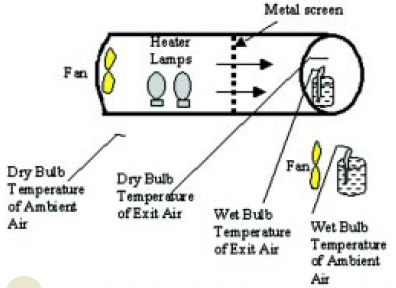 The experimental setup is shown in Fig. 1. A 15-cm-diameter, 50-cm-long PVC pipe is used. An 8-cm-diameter fan is attached to one end, and two 200-W lamps are installed inside the pipe. Two Type K thermocouples are located outside the pipe; one measures the dry-bulb temperature, and the second is covered with a cotton wick that draws water by capillary action from a beaker full of water. Another fan of the same size runs continuously to provide adequate air flow around the ambient wet-bulb thermometer. Two thermocouples located at the exit of the pipe measure dry- and wet-bulb temperatures of the exit air
The experimental setup is shown in Fig. 1. A 15-cm-diameter, 50-cm-long PVC pipe is used. An 8-cm-diameter fan is attached to one end, and two 200-W lamps are installed inside the pipe. Two Type K thermocouples are located outside the pipe; one measures the dry-bulb temperature, and the second is covered with a cotton wick that draws water by capillary action from a beaker full of water. Another fan of the same size runs continuously to provide adequate air flow around the ambient wet-bulb thermometer. Two thermocouples located at the exit of the pipe measure dry- and wet-bulb temperatures of the exit air
--- PAGE BREAK ---
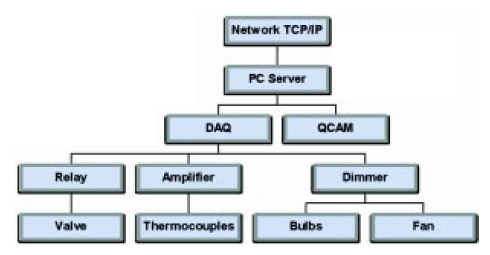 A desktop PC computer (Dell) is used as a server. While the server may use either Unix, Linux, or Windows, we chose Linux for its cost-effectiveness (available free at present) and high reliability. The various inputs and outputs, namely, four thermocouples, fan, and heater, are connected to the server as shown in Fig. 2. A separate input for operating a valve to feed water into the reservoir is available. The software written for access and control on the Internet is executed in Linux. We plan to make a documented version of the computer code for data acquisition and control available to any interested instructors.
A desktop PC computer (Dell) is used as a server. While the server may use either Unix, Linux, or Windows, we chose Linux for its cost-effectiveness (available free at present) and high reliability. The various inputs and outputs, namely, four thermocouples, fan, and heater, are connected to the server as shown in Fig. 2. A separate input for operating a valve to feed water into the reservoir is available. The software written for access and control on the Internet is executed in Linux. We plan to make a documented version of the computer code for data acquisition and control available to any interested instructors.
 A student begins the experiment by using a computer connected to an Internet service provider. Using a browser (either Netscape or Microsoft Internet Explorer), the student enters the following address http://food.engr.ucdavis.edu/lab. The first screen (Fig. 3) requests a login and a password.
A student begins the experiment by using a computer connected to an Internet service provider. Using a browser (either Netscape or Microsoft Internet Explorer), the student enters the following address http://food.engr.ucdavis.edu/lab. The first screen (Fig. 3) requests a login and a password.
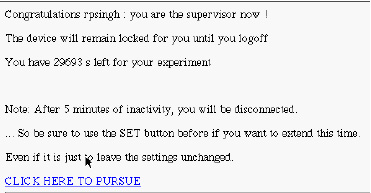 After the preassigned information is entered, a screen (Fig. 4) informs the student that he or she has permission to control the various available features. If the student does not have a login and password, a visual-only access is available to view an ongoing experiment. The next screen (Fig. 5) shows a live image of the experimental setup. Using an approach similar to “push” technology, the image is updated automatically every 5 seconds on the student’s monitor. There is a link for the student to open an html file that describes various concepts important to the experiment, and there is a link to the instructor’s e-mail address. The live image seen by the student is that of a heating device constructed from off-the-shelf components (total cost under $500, not including a desktop computer used as a server).
After the preassigned information is entered, a screen (Fig. 4) informs the student that he or she has permission to control the various available features. If the student does not have a login and password, a visual-only access is available to view an ongoing experiment. The next screen (Fig. 5) shows a live image of the experimental setup. Using an approach similar to “push” technology, the image is updated automatically every 5 seconds on the student’s monitor. There is a link for the student to open an html file that describes various concepts important to the experiment, and there is a link to the instructor’s e-mail address. The live image seen by the student is that of a heating device constructed from off-the-shelf components (total cost under $500, not including a desktop computer used as a server).
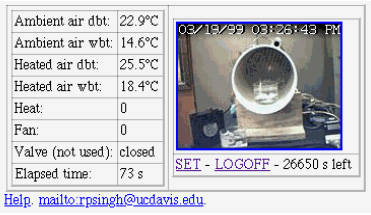
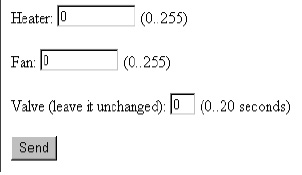 As shown in Fig. 5, the student is asked to click on a button, SET. In the next screen (Fig. 6), values are entered for the fan speed and the heater power. The value may be any number between 0 and 255. This gives the student the opportunity to try different experiments with different levels of heat input and rates of airflow.
As shown in Fig. 5, the student is asked to click on a button, SET. In the next screen (Fig. 6), values are entered for the fan speed and the heater power. The value may be any number between 0 and 255. This gives the student the opportunity to try different experiments with different levels of heat input and rates of airflow.
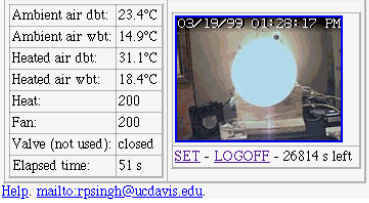 Upon entering any desired numbers for the fan and heater, the following screen (Fig. 7) shows the live image of the experimental setup updated every 5 seconds. The student views that the heater lamps are indeed switched on, and the dry-bulb and wet-bulb temperatures of heated air begin to increase. The student is asked to run the experiment for about 450 seconds. During this time, the data are continuously recorded every second. To end the experiment, the student clicks on the SET button, and changes the values of the fan and heater back to 0.
Upon entering any desired numbers for the fan and heater, the following screen (Fig. 7) shows the live image of the experimental setup updated every 5 seconds. The student views that the heater lamps are indeed switched on, and the dry-bulb and wet-bulb temperatures of heated air begin to increase. The student is asked to run the experiment for about 450 seconds. During this time, the data are continuously recorded every second. To end the experiment, the student clicks on the SET button, and changes the values of the fan and heater back to 0.
--- PAGE BREAK ---
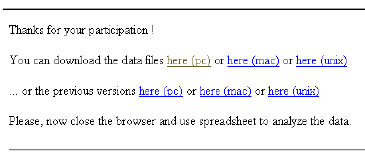 In the next image of the setup, the student sees that the heater lamps have in fact been turned off. The student then clicks the LOGOFF button and is prompted (Fig. 8) to download the collected data in either PC, Mac, or Unix format. Upon selecting the desired format, the data file is downloaded from the server to the student’s computer.
In the next image of the setup, the student sees that the heater lamps have in fact been turned off. The student then clicks the LOGOFF button and is prompted (Fig. 8) to download the collected data in either PC, Mac, or Unix format. Upon selecting the desired format, the data file is downloaded from the server to the student’s computer.
The last screen thanks the student on having successfully completed the experiment, and a set of five questions (Davis et al., 1974) are asked for immediate feedback regarding the experiment. The student may repeat the experiment for other settings of heater and fan or close the browser and use a spreadsheet application (Singh, 1996b) for further data analysis.
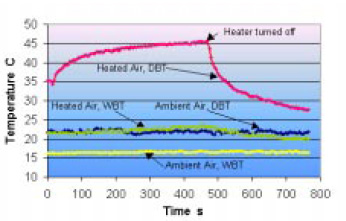 The data obtained from the experiment are shown in Fig. 9. The student uses the temperature data at 400 sec (near steady state) to plot the heating cycle on a psychrometric chart. Additional calculations involve determining humidity ratios and enthalpies of inlet and exit air, and conducting an overall enthalpy balance using the given air flow rates (Singh and Heldman, 1993).
The data obtained from the experiment are shown in Fig. 9. The student uses the temperature data at 400 sec (near steady state) to plot the heating cycle on a psychrometric chart. Additional calculations involve determining humidity ratios and enthalpies of inlet and exit air, and conducting an overall enthalpy balance using the given air flow rates (Singh and Heldman, 1993).
Three Applications
We envision that the use of remote-conducted experiments will be in several modes, including the following.
• Pre-Experiment Exercise. Students will be asked to conduct a given experiment prior to coming to the laboratory. Having conducted an Internet-assisted hands-on experiment, the student will be better prepared to discuss related topics with the instructor. Followup experiments may then be conducted with related food process equipment if available.
The advantage of this approach is that every student participates in a hands-on experience despite the class size. It is not uncommon in laboratory classes with large enrollments for only a few students in a group to actively participate in all given tasks; several remain passive observers. By requiring each student to conduct an Internet-assisted experiment prior to attending a laboratory, each student will be better prepared to later work in a group and conduct additional measurements to enhance his or her learning experience. The server keeps a record of names of students who successfully complete an assigned experiment.
• Stand-Alone Exercise. Students may be able to conduct experiments when the required facilities at their respective institutions are not available.
• Lecture-Only Classes. Typically, in lecture-only classes, homework assignments are given that are created with hypothetical data. By incorporating Internet-assisted experiments in those assignments, students will obtain real data for use in problem solving, gaining further insights.
--- PAGE BREAK ---
Issues to Be Addressed
In developing this demonstration experiment, we have identified several issues that will be important to address in future work in this area:
1. How do we make the system robust and reliable? This includes the availability of the network at all times, and in case of a power failure, the ability of the network to return to preset conditions.
2. How do we maintain the security of the network?
3. How will the safety of the experimental equipment be maintained? Can we sufficiently anticipate problems before they arise? For example, in the demonstration experiment, the fan within the system runs at a slow speed at all times to avoid any overheating if the lamps are left on for a long period.
4. How many experiments can be run simultaneously using a single computer server?
5. How can objects be moved in an experimental setup for desired placement? For example, in measuring thermal conductivity of a solid food object, it is necessary to insert a probe into an object. This would be possible with the use of a robotic arm that may be manipulated remotely. For safe operation, only limited movements of the arm are permitted.
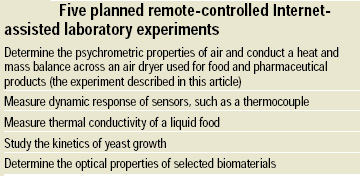 To answer these questions, we are planning to create a set of five Internet-assisted laboratory experiments (Table 1) to demonstrate the application of selected food and bioprocess engineering concepts. These exercises are drawn from transport phenomena and kinetics. In addition, they offer different levels of challenge in preparing material suitable for the Internet. The experiences gained in this study will be shared with other instructors who may want to develop future laboratory exercises at their own locations.
To answer these questions, we are planning to create a set of five Internet-assisted laboratory experiments (Table 1) to demonstrate the application of selected food and bioprocess engineering concepts. These exercises are drawn from transport phenomena and kinetics. In addition, they offer different levels of challenge in preparing material suitable for the Internet. The experiences gained in this study will be shared with other instructors who may want to develop future laboratory exercises at their own locations.
Several mechanisms are anticipated for obtaining evaluations from students conducting experiments:
• At the end of each experiment, a student will be asked a list of selected questions to assess his or her understanding of the tasks just completed. That information will be collected at the server and analyzed after multiple students have conducted experiments. At the end of a course, student feedback also will be obtained through written course evaluations. The responses will be analyzed to determine how a student’s comprehension is enhanced with an Internet-assisted hands-on experiment.
• Instructors from other universities will be surveyed to determine how their students benefited when they used the remote-controlled experiments. Records will be kept to identify when an experiment available on the Internet was the only method of providing a student with hands-on experience.
• Instructors’ responses on the material supplied to them for developing such laboratories at their locations will be obtained. This information will be useful for determining ways to revise the computer codes and provide the most useful information for other instructors.
Offers Opportunities
Internet-assisted laboratory exercises offer unique opportunities to develop educational materials for the new generation of computer-savvy students. These exercises provide an increased level of interactivity between a student and the educational materials provided on the Internet. Development of such experiments is expected to harness the innovative creativity of food science educators on a truly global basis.
by R. PAUL SINGH AND FRANCIS COURTOIS
Author Singh, a Professional Member of IFT, is Professor of Food Engineering, Dept. of Biological and Agricultural Engineering, University of California, Davis, CA 95616. Author Courtois is Maître de Conférences, Food Engineering Dept., ENSIA-INRA, 1 Ave. des Olympiades, 91744 Massy Cedex, France. Send reprint requests to author Singh.
Based on a paper presented during the Annual Meeting of the Institute of Food Technologists, Chicago, Ill., July 24–28, 1999.
by Edited by Neil H. Mermelstein,
Senior Editor
References
Aichoune, H. 1999. Personal communication. ENSIA, Massy, France.
Courtois, F. 1998. Setup of low cost experimental device for teaching of food process modeling and control. Internal Report, ENSIA, Massy, France.
Davis, R.H., Alexander, L.T., and Yelon, S.T. 1974. “Learning System Design. An Approach to Improvement of Instruction.” McGraw-Hill, New York.
Farkas, B.E. 1999. Personal communication, North Carolina State Univ., Raleigh.
NAS. 1997. Preparing for the 21st century: The education imperative.” Natl. Acad. of Sciences, Washington, D.C.
NASULGC. 1997. Returning to our roots: The student experience. A Kellogg Commission Report. Natl. Assn. of State Universities and Land-Grant Colleges, Washington, D.C. (www.nasulgc.nche.edu).
NSF. 1996. Shaping the future: New expectations for undergraduate education in science, mathematics, engineering, and technology. Natl. Science Foundation, Washington, D.C.
Rizvi, S.S.H., and Mittal, G.S. 1992. “Experimental Methods in Food Engineering.” Van Nostrand Reinhold, New York.
Rudenstine, N.L. 1997. The Internet and education: A close fit. Chronicle Higher Educ. 43(24): A48.
Singh, R.P. 1996a. Teaching food science and technology on the World Wide Web. Food Technol. 50(3): 94–99.
Singh R.P. 1996b. “Computer Applications in Food Technology; Use of Spreadsheets in Graphical, Statistical, and Process Analysis.” Academic Press, San Diego.
Singh, R.P. and Heldman, D.R. 1993. “Introduction to Food Engineering.” Academic Press, San Diego.
Wells, J.H. 1999. Personal communication. Oregon State Univ., Portland.
Wong, M. 1999. Personal communication, Massey Univ., Auckland, New Zealand.
